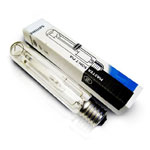Did you know that? Lumens are for humans.
Discover what is needed for your plants.
It is above all photons
Many lamp manufacturers still specify the output of their lamps (illumination) in lumens. In reality, this unit indicates how humans perceive the intensity of this light, not plants.
Indeed, our eyes are more sensitive to green light with a spectrum of 555 nm while plants are sensitive to a much broader spectrum of 400 to 700nm.
So, what is the right way to specify the technicalities of horticultural lamps and how to calculate this on your bulbs and lamps of different type?
What's in your light spectrum? Enter the photons.
PAR spectrum
Did you know that? Plants mainly use light from 400-700 nm bandwidth (violet to far red). The light in this bandwidth is called photosynthetically active radiation (PAR). So the width of the light spectrum to which plants are sensitive is much wider than what we see with the human eye.
The use of lights, measured in terms of what the eye is sensitive to, is therefore not a correct representation of the growing light properties of a grow light suitable for your plants.

What is a photon?
Scientists have proven that there is a relationship between the number of photons and photosynthesis of plants. It takes about 8 to 10 photons to bind one molecule of CO2.
Scientists have also discovered that there is little difference in the efficiency of blue or red light.
There is therefore a direct relationship between the number of photons in the PAR spectrum and the photosynthetic potential of a plant (and ultimately the yield of a plant and its abundant crops).
For many years, professional researchers have been using photon counts in the PAR spectrum as a standard and the greenhouse industry has followed suit very quickly.
Most European manufacturers of high-end horticultural lamps in terms of spectrum quality specify the output of their lamps in PAR photons per second Superplant lighting and its special electronic HPS lamp, the most efficient in the industry, followed by Sylvania Grolux or Philips SonT plus, Gavita far behind Superplant in the tests carried out by Hortinews the blog which tests the innovative products for you.
All these specify the output of their lamps in PAR photons per second. Because photons come in large numbers a multiplier is used, in this case constant (6.0221415 × 10 23) of Avogadro to get an expression in mol. 1 photons mol is 6.0221415 × 10 23 photons. Now, this is a lot of photons and to get that levels that become easier to understand, they are divided by 1 million, creating micro-moles (μmol). So , 1 umol is 6.0221415 × 10 17 photons.
To illustrate why μmol/m2 is simply much better for us at least for our plants: the PPF of a 600W HPS lamp is about 1100 μmol / second. If you express that, in moles, it would be 0.0011 mol / s. Now this is a little more difficult to calculate with.
For this there are quantum meter full spectrum allowing easy calculation of UMOL/M2 with your portable machine and see where your losses are, this will allow you to improve your results and get more abundant crops, think PPFD and not lumens.
Photosynthetic Photon Flux (PPF)
Photons are counted per second when we count a flux or stream of photons. If you count all the photons a lamp emits in the PAR spectrum per second, you get the photosynthetic photon flux (PPF). The only way to measure it accurately is in an integrating sphere, the Ulbricht sphere. Thus, PPF is measured in μmol / s and represents all photons in the range of 400-700 nm per second. But how far will this reach your plant and how far?
Photosynthetic Photon Flux Density (PPFD)
Let's say we mount the lamp in a very good horticultural reflector of type Adjust a Wing, Xtracool, Black OGetc. whose total efficiency is 95%. This figure means that in the 100% of light from the lamp, 95% is totally emitted by the direct light from the lamp or the reflected light from the reflector.
You can also say that your reflector losses are 5%. Now, if you spread your 1100-5% over an area of 1 square meter, you will irradiate 1045 pmol / m 2 / s (1.045 pmol m -2 s -1). This is called the photosynthetic photon flux density.
If I get closer to the source and just want to light a half square meter, the irradiance would be 2090 pmol m -2 s -1. And of course, spread over 4 m 3 you would get 261 pmol m -2 s -1. Double the area means half the PPFD.
Just divide the PPF by the illuminated area inm2 pto get closer to the calculated PPFD. You will always have stray light losses (much more with open reflectors!) And you have an influence by wall reflection, which causes a loss.
You can easily measure the PPFD with a quantum meter and a sensor that is specifically designed for the PAR spectrum. Unfortunately, real quantum meters are expensive. Li-Cor or APOGEE meters are used throughout the industry and are recommended for testing your crops and the diffusion of your lamps within your rooms or intensive growing spaces. Most meters under $500 use lumen sensors and an internal table to approximate PPFD in micromoles. We have found them to be inaccurate because they are still sensitive to certain colors and do not take other colors in the PAR spectrum into account. The best test product is the apogee MQ 500 full spectrum quantum meter guaranteed by the best growers in the indoorindustry.
And what about the light spectrum?
The terms PPF and PPFD only qualify the quantity of photons, not the quality of the spectrum. If the spectrum was not important, you would be able to grow any plant under a single red LED color for example which is not the case the horticultural led spectra are much more mixed.
Plants need different colors for different processes.
The color of the light specifically influences the shape, construction and development speed of the plant during these different periods of indoor growing.
In greenhouses, sunlight provides quality light. HPS lamps are used for additional and complementary photons, to get the maximum amount in your crops.
So yes, the spectrum is important, especially when growing indoors where there is no sunlight. Plants have been growing under sunlight for millions of years, so you can expect them to be adapted to this spectrum and they use all the data as efficiently as possible.
Calculating micromoles
If you know how much light you need for optimal plant growth, it's easy to calculate how many lamps you need. There is one complicating factor, and that's the walls.
Did you know that the walls reflect only part of the light? The reflective material used of type Orca is the best film, 99% reflection or Mylar Diamond or classic to achieve 90% reflection for example. When you use diffuse reflective materials such as mylar, not all of the reflected light will reach your crop.
So there are significant losses at the edges of your grow room. One way to solve the problem is to keep your end fixtures closer to the wall than half the distance between fixtures in the room to allow for more direct light and reflection from the sides to even out the overlap. An adjustable reflector type Adjust a Wing Enforcer o r Adjust a Wing Defender or Avenger that sends light down the side of the wall can save you a lot of light.
Discover in preview the new lamp of Adjust a Wing named HELLION a double ended lamp kit 450W , 600W , 750W with double ended bulb Adjust a Wing discover the best lighting products at Culture Indoor, your online growshop since 2002.
When you have a SPACE with a lot of lights, you will have a great advantage when you overlap your light. Suspending your lights higher from the crop will create more spread and a lower PPFD per fixture, but you can add overlapping of other lights to get the same light on your crop all the time and get evenness of your light on your plants, but at a greater distance. This is much easier for climate control and more uniform light from different directions, allowing better penetration into your intensive crop.
Examples of recommendations for a high light of about 700 pmol m -2 s -1. Calculations made with 10% reflector / wall losses:
400W a ) - 1 x 1 m - 1 m 2 at a PPFD of ~ 650 pmol m -2 s -1
S 1.44 m 2 at a PPFD of ~ 690 pmol m -2-1- 600W b) - 1.2 x 1.2 m
1000W c) - 1.5 x 1.5 m - 2.25 m 2 at a PPFD of ~ 800 pmol m -2 s -1
In practice, the levels can be lower with different reflectors( open reflectors will have more stray light), older reflectors and a lot of wall influences
 |
 |
 |
 |
| Philips GreenPower 400W 230V ppf 725 μmol |
Philips GreenPower 600W 230V ppf 1100 μmol |
Philips GreenPower 1000W 400V electronic ppf 2000 μmol | Superplant electronic 600W 230V ppf 1336 umol |
Knowing that only the bulb Superplant is reinforced for the electronic ballasts it becomes the best bulb on the market without comparison, Gavita, Lumatek sunmaster far behind Superplant Lighting, a French brand.

